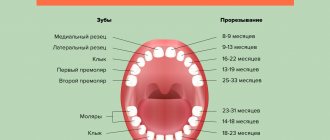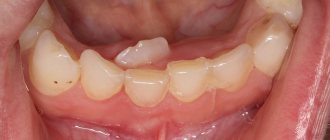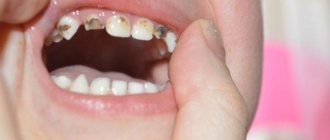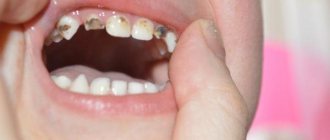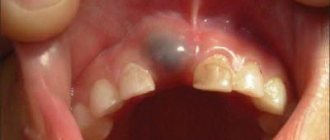How many baby teeth do children have?
Milk teeth and even some molars begin to form at the stage of intrauterine development. Of course, a child has no visible teeth at birth - they begin to erupt only after 6 months. During this six-month period, they are hidden under the gums, but slowly develop and form, beginning to move outward.
In total, a child grows 20 baby teeth:
- Central and lateral incisors – 8.
- Fangs – 4.
- First and second molars – 8.
Their main function is to form a space where molars will then grow.
Dental formula
In order to improve the convenience of describing each tooth, numbering them, and filling out cards, it is customary to record the order of the teeth using a special formula. There are several varieties of it.
Zsigmondy-Palmer system (quadratic-digital)
Arabic numerals are used, numbering starts from the central incisors in each direction:
- 1 and 2 – incisors.
- 3 – fang.
- 4, 5 – premolars.
- 6-8 – molars.
Milk teeth are designated differently - using Roman numerals:
- I and II – incisors.
- III – fang.
- IV and V – molars.
Two-digit Viola system
Teeth numbering uses 2 digits. The jaws are divided into 4 quadrants. The first digit shows its number.
For adults this is:
- 1 – upper jaw on the right.
- 2 – upper jaw on the left.
- 3 – lower jaw on the left.
- 4 – lower jaw reference.
For a similar description of baby teeth, numbers 5 to 8 are used.
So, there are 8 teeth in each quadrant, its number is shown by the second digit. Thus, the first molar of the lower jaw on the left is designated 35, and the child’s canine from the lower right is designated 43. Therefore, the phrase that “treatment of the 48th tooth is required,” or, for example, the 55th, does not indicate the doctor’s lack of qualifications or what - or pathology in your child, who suddenly acquired so many teeth.
How many teeth should a child have per year?
During this period, baby teeth begin to cut.
They begin to break out in the following sequence on the upper and lower jaws. On the top:
- 8-12 months. Central incisors.
- 9-13 months. Lateral incisors.
- 16-22 months. Fangs.
- 13-19 months. First molars.
- 25-33 months. Second molars.
In the lower jaw, this process is distributed in time somewhat differently:
- 6-10 months. Central incisors.
- 10-16 months. Lateral incisors.
- 17-23 months. Fangs.
- 14-18 months. First molars.
- 23-31 months. Second molars.
It is worth noting that these time limits are averaged and deviations up or down by 1-3 months are considered normal.
If you want to know how many teeth a child has per year is considered normal, you should refer to the chart described above. You get that at the age of 12 months there should be 6-8 of them.
Main signs and symptoms
Many parents are in a hurry to find out how their children are teething, especially those who are faced with this phenomenon for the first time. Rarely does such a process go unnoticed; most often it manifests itself with characteristic symptoms.
Experts call the following main symptoms that a child is teething:
- worsening sleep;
- increased moodiness and tearfulness of the baby;
- Bad mood;
- swollen and sore gums;
- loss of appetite, sometimes even leading to refusal of food;
- increased salivation;
- the child puts everything into his mouth, so he tries to relieve the pain;
- the formation of various redness and rashes around the mouth caused by skin contact with saliva.
In addition to the main signs indicating the appearance of teeth in children, accompanying symptoms can also be traced. Due to the increased function of the salivary glands, the following may be observed:
- runny nose;
- hoarseness of voice;
- cough without sputum production;
- indigestion in the form of diarrhea.
Often, as a child teethes, the body temperature rises. Usually it stays at around 37.5 ̊C, but it can rise to 39 ̊C.
The most severe pain is accompanied by the eruption of fangs. They have very sharp edges that cut through the gums and cause severe pain. The appearance of the upper “eye teeth” is especially painful, as they are closely connected to the facial nerve.
The approximate timing of eruption of milk jugs is presented in the table below.
| Tooth name | Baby's age |
| Central incisors | Below - at 6-9 months, above - 7-10 |
| Lateral incisors | On the upper gum – 9-11 months, on the lower gum – 11-14 |
| First molars | In the bottom row - in a year and a half, in the upper – 13-20 months |
| Fangs | In the lower dentition - 16-22 months, in the upper dentition - 17-23 |
| Second molars | Below - at 20-26, above - at 26-33 |
Please remember that this is just a rough guide to teething timing. Later dates are also acceptable, but not later than 6 months.
Changing baby teeth to molars
Around the age of 4, a child’s growth spurt begins, the jaws enlarge and the baby teeth seem to move apart, with gaps appearing between them – trema. If this does not happen and by the age of 5 the teeth are still tight, you need to show the child to the dentist, as there may not be enough space for permanent teeth.
At about 5-6 years of age, baby teeth begin to become loose and gradually fall out, which indicates that the molars are already beginning to grow underneath them. Usually this process of change lasts for 5-8 years and the final formation of the dentition occurs somewhere around 14-15 years.
This happens in the following order:
- 5-6 years – lower and upper incisors.
- 7-8 years – lower and upper lateral incisors.
- 8-10 years – upper and lower molars.
- 9-11 years – upper and lower canines.
- 11-13 years – upper and lower molars.
Milk teeth are replaced by permanent molars. Their number at the age of 14-16 years is 28. At the same time, the third molars (wisdom teeth) are already formed, but they begin to grow only after 18 years. True, not all people grow them. It all depends on individual characteristics.
Possible problems
At the moment the molars appear, certain dental problems are possible. In order to take timely measures to eliminate them, parents must have an idea about them.
Molars do not erupt
A situation is possible in which baby teeth do not fall out in a timely manner, or they have fallen out, but molars have begun to appear in their place. The reason for this must be determined by the dentist, who must be visited without delay. A general x-ray is usually taken to show the degree of development of the molars.
Among the options for the lack of eruption of molars in due time can be indicated:
- Hereditary predisposition, which is the cause of a possible delay in the appearance of molars. If the x-ray shows that the process of forming the rudiments of teeth is underway, then you will just have to wait a little for their appearance.
- Adentia. Disturbances in the processes of formation of tooth germs during the intrauterine development of a child, inflammatory processes can lead to a similar pathology - the absence or death of tooth germs. The solution is prosthetics.
Pain
The first time after teething, the tooth is poorly protected from caries and the effects of various bacteria. This is explained by the low degree of enamel mineralization at the initial stage. Almost nothing interferes with the development of caries; tooth tissue is destroyed, pulpitis occurs, with the subsequent risk of its transition to periodontitis. Severe pain, changes in body temperature and deterioration in well-being may occur.
It is highly advisable not to let the situation get worse, not to cause severe pain, but to visit a dentist as soon as painful sensations appear. If a child is predisposed to caries, it is better to carry out preventive procedures, for example, fissure sealing. The folds on the chewing surface are covered with a composite material that protects such natural cavities from the accumulation of food debris in them, the development of bacteria, and inflammatory processes.
In the worst case, you can lose a tooth.
Teeth grow crooked
A common situation is when the molar has already begun to erupt, but the baby tooth does not want to fall out. The result is that the new tooth seeks alternative growth paths, which leads to its displacement and change in the direction of growth. Hence the malocclusion and the alignment of the dentition. Treatment by an orthodontist will be required.
If this situation occurs, you should not remove or loosen a baby tooth yourself; you should visit a doctor.
Loss of molars
An alarming symptom of the presence of diseases (caries, etc.) in the oral cavity, or there are problems with the entire body (connective tissue diseases, diabetes, etc.). A visit to the doctor is mandatory.
This is necessary to develop a strategy for restoring a lost tooth. This is necessary for the proper growth of the remaining teeth and the formation of the maxillofacial system. Considering that the jaw tissue is still in the process of growth, prosthetics are only possible temporary, which must be adjusted as the jaws develop. Permanent prosthetics will be available only after their formation is completed.
Injuries
The first few years after teething, teeth are at increased risk of injury from impact. Sports injuries, falls, and blows can lead to chipping of parts of the tooth and cracks. Be sure to contact a dentist who will restore the lost part with modern materials.
How many teeth should a child have?
It all depends on age. The maximum number of teeth in the period from birth to 5-6 years is 20 - these are milk teeth. Then, until the age of 15-16, the molars begin to erupt, pushing out the milk teeth. Ultimately, their number grows to 28.
The latest are the third molars. They grow only after 18 years of age, but not everyone has them.
It is worth noting that the period of formation and eruption of baby teeth is very individual. In some children, all 20 teeth grow by the age of 2, while in others - by 2.5 or later. Such delays within a year are considered normal and are not a developmental anomaly.
If teeth do not start cutting in the first year of the baby’s life, you should consult a doctor to find out the reasons.
To the list of posts
Teeth are cutting!
A seven-month-old child has a fever, his nose is running, he refuses to eat... Is it really ARVI again? After all, you just recently got sick? Or maybe the child isn’t sick after all? But then where do these symptoms, typical of colds, come from?
You can read about the symptoms of ARVI in children here
Today, with Valeria Aleksandrovna Golovko, a pediatrician at Clinic Expert Tula LLC, we are talking about long-awaited teeth. How many months does the first tooth appear? What accompanies their appearance? Our article is about this and much more.
- The first thing parents expect from a child is a smile, then his “aha”, but the most exciting expectation is whether the baby will have teeth? When do babies' first teeth start to grow?
According to statistics, the first milk teeth appear on average at 6-8 months of age. As a rule, these are the middle lower incisors.
The onset of teething depends on a number of factors. From which ones exactly?
— heredity or, in other words, the timing of the appearance of teeth in the baby’s parents;
- full-term baby. Premature babies may develop teeth later;
- the child’s nutrition, namely, sufficient intake of calcium into the body (after the start of complementary feeding, the main sources of calcium are cottage cheese and somewhat less - kefir);
— sufficient intake of vitamin D into the body. Its natural sources are egg yolk and butter;
— climatic conditions. Children living in hot climates erupt teeth earlier;
- gender of the child. Girls erupt teeth earlier;
- sometimes a deviation in the period of teeth appearance from the statistical average in one direction or another occurs in situations where a baby has 1-2 teeth immediately after birth. They are usually always defective and quickly fall out or are removed.
- What is the pattern of baby teeth eruption in children?
First, the lower middle incisors appear (simultaneously or in turn). Then 4 upper incisors erupt, and then 2 lower lateral ones. On average, a baby has 8 teeth by the age of one year.
After this, the molars (premolar teeth) are cut. The lower anteriors appear somewhat earlier (at 12-18 months), and the upper anteriors appear later (at 13-19 months).
Then the rear molars appear: the lower ones - from 20 to 31 months, and the upper ones - from 16 to 22 months.
Canines: lower - from 16 to 23 months, and upper - from 16 to 22 months.
Those. By the age of 3, a child has 20 primary teeth, i.e. incisors, canines and molars.
Individual differences should also be kept in mind, i.e. this number of teeth can be at 2 or 2.5 years.
- Let's talk about the first signs of teeth appearing in a baby. What could they be?
One of the first manifestations is redness and swelling of the gums. Salivation increases. Appetite worsens, up to complete refusal to eat. Irritability increases and sleep is disturbed. The baby asks to be held more often, and physical activity increases. The reason is itching and sore gums.
- What painful symptoms can accompany the appearance of teeth in a child?
This is salivation, nasal congestion and discharge from it. Sometimes there is a cough/cough, stool disturbances in the form of loosening (but maintaining the normal frequency of bowel movements). There may be irritation of the skin of the mouth, chin, chest, i.e. areas where saliva enters. In some cases, the temperature rises: more often not higher than 38.5°C, less often - 39°C and higher, often subsides on the second or third day. The child may become irritable.
Vomiting and diarrhea are less common: in this case, you need to be especially vigilant, since these signs may not be associated with teeth, but indicate some kind of disease - for example, rotavirus infection.
What to do if your child has a stomach ache? The story is told by the surgeon, Deputy Chief Physician for Pediatrics at Clinic Expert Smolensk LLC Alexey Alexandrovich Zakharov
- How to relieve baby's teething pain?
This task is not easy. First of all, it is necessary to ensure that the baby has the opportunity to chew sufficiently. This is what teethers are designed for. Massaging your gums may help.
Gels are also used when teething in children, but their disadvantage is that they can cause an allergic reaction.
There are homeopathic rectal suppositories. According to indications, antipyretic and analgesic syrups can be used.
-Which teethers are best to use?
They must be elastic and durable (and therefore safe). The best ones are silicone, latex, having the appropriate anatomical shape to form the correct bite.
There are also plastic teethers that contain liquid or gel inside. Before use, they are cooled in the refrigerator (at +6°C) and only then given to the child. The additional cold factor also reduces pain to a certain extent. The downside is that these teethers need to be constantly cooled.
A separate advantage of teethers is their positive effect on fine motor skills.
-Can I use carrots, apples or cookies instead of teethers?
In principle, it is possible, but, firstly, these products should already be in the child’s diet; secondly, their use should not begin when the first teeth erupt: at least, all incisors should be present; and thirdly, the child must be able to swallow food well. If you give a teething child an apple, carrot or cookie, you must ensure that the child does not choke.
- How do you feel about using traditional methods to help a child who is teething?
Overall positive, however, only after consulting a doctor. Why? Sometimes, for example, when teething, herbal decoctions are used, but at the same time, one should remember the possibility of allergic reactions.
Is your child suffering from allergies? Ulyana Vladimirovna Chemova, an allergist-immunologist at Clinic Expert Smolensk, tells how to help a baby.
In particular, a decoction of chamomile flowers and a ready-made high-quality aqueous solution of propolis are used.
- Are the first teeth and their appearance a reason to contact a pediatrician or should you go to see him only if something worries you?
Sometimes, under the “mask” of teething, the onset of an infectious disease can be hidden. Therefore, if two or more of the signs that I mentioned earlier are detected, you need to contact your pediatrician.
You can make an appointment with a pediatrician in your city here
- Does teething always affect the general condition of the baby? Or can teeth appear easily and without parents even noticing?
No, the general condition does not always change. In some cases, parents find out about an erupted tooth by catching it with a spoon when feeding the child.
- What is the most important thing when teething? How can parents and their children survive this period calmly?
A universal remedy - double parental affection, attention and care for the baby. Don’t be afraid to pamper your child, carry him in your arms more - this will add calmness to the baby and create a sense of security.
It should be remembered that this period is not very long and, like everything, it too will pass and will later be remembered with a smile.
- The anxiety is over, the first teeth have appeared. How to properly care for them?
As soon as the first tooth appears, you can visit the dentist and begin oral care. There are special silicone brush attachments (put on your finger) that can be used to treat the teeth of even a 6-month-old child. This should be done at least once a day until the age of one year. From the age of one, you can brush your teeth with a very soft toothbrush, moving from the gums to the cutting edge of the tooth or chewing surface.
You might be interested in:
What will help with a cough: badger fat or mustard in socks? We treat children correctly
Your immune system is under control! We create a strong rear for the child
Are unvaccinated children the healthiest?
For reference:
Golovko Valeria Alexandrovna
Graduate of the Faculty of Medicine of Tula State University in 2004.
In 2005, she completed an internship in the specialty “Pediatrics”
Currently working as a pediatrician at Clinic Expert Tula LLC.
Permissible deviations
Don't be too alarmed if teeth erupt at intervals of several months or in the wrong order. But if the baby does not have incisors after 1 year, this is a reason to consult a specialist.
Usually, when the first tooth appears late, then all the others begin to cut late. If there is a hereditary factor, there is no need to worry.
Factors influencing deviations from the norm:
- weakened immune system;
- use of medications by the mother during pregnancy;
- sucking on a pacifier for a long time;
- lack of breastfeeding, bottle feeding;
- lack of vital elements in the diet;
- lack of necessary load on the jaws (mashed food).
Premature babies, babies with high body weight, and children on IV are at risk.
An acceptable deviation from the norm is a lag of six months. If a tooth begins to erupt with a discoloration, shape, or in the wrong direction, the baby should be shown to the dentist.
It is advisable to consult if teeth appeared too early or one of the paired incisors or molars is missing for a long time. Gaps in the dentition can be both normal and pathological.
In this video, the pediatrician talks about how many teeth should be at 2 years old and what to do if your child has deviations from the norm.
Cutting speed
At first, parents wait impatiently for the first tooth, examining the baby's gums for restless behavior. When the incisors begin to erupt one after another, it is rare for a baby to tolerate this process calmly. Moms and dads often want to speed it up, but little depends on them. The speed of teething is affected by:
- features of hereditary predisposition;
- the state of the endocrine system of the baby and mother during pregnancy;
- the state of the environment in the area of residence;
- state of the immune system;
- period of appearance of the first incisor;
- infectious diseases and rickets;
- supply of nutrients to the body.
Interesting fact. Often teeth appear early in firstborns and children of late-parous parents. The most problematic one is usually the first tooth.
Useful tips
The root cause of diseases affecting the baby’s oral cavity is the incorrect actions of parents. To avoid problems such as caries, fluorosis, and enamel hypoplasia in the future, the following recommendations must be followed:
- For any abnormalities, make an appointment with your child to see a doctor.
- After teeth emerge, clean them with a special baby brush that fits on your finger.
- After 2 years, teach children to brush their teeth independently under adult supervision.
- For very small babies, brush their teeth with a weak soda solution or just with a damp brush. A 2-year-old child can brush his teeth using toothpaste.
- Buy a toothbrush according to your age group. The same goes for pasta.
- Brush your teeth with gentle movements without pressure.
- Choose fluoride-free baby toothpastes.
Folk remedy. You can gently clean children's teeth from pathogenic microflora with propolis infusion, a water-salt solution, or a decoction of sage or chamomile.
